Online
-
Lezingen in mei
Overzicht van Egyptologische lezingen in mei, zowel hybride als online, en de NINO-EOL voorjaarslezing.
Zie ook deze online/hybride lezingenseries:
Conceptualizing Bodies in Ancient Egypt
Egyptologisch Instituut Mainz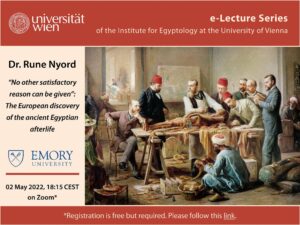 Maandag 2 mei, 18.15 uur (online)
Maandag 2 mei, 18.15 uur (online)No other satisfactory reason can be given”: The European discovery of the ancient Egyptian afterlife
Dr. Rune Nyord (Emory University)The modern understanding of the ancient Egyptians as bent on a quest for eternal life is the result of a long history of Western engagements with ancient Egypt. Associations like the preservation of bodies for eternity and initiation into religious mysteries interacted with textual sources of the Biblical and Classical traditions to shape images of the ancient culture that could be deployed in a variety of contexts for theological, ideological, colonial, and other purposes. This lecture examines some key formative moments in this tradition, suggesting that many aspects of the modern understanding of Egyptian afterlife beliefs owe as much to the contemporary concerns of the milieus that helped shape them as to the ancient Egyptian sources that were only gradually becoming known as these ideas were crystalizing.
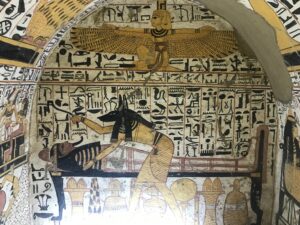 Donderdag 5 mei, 20.00 uur (online)
Donderdag 5 mei, 20.00 uur (online)The Turin Museum’s current research at Deir el-Medina
Cédric GobeilKosten: £5
Within the framework of the French Archaeological mission at Deir El-Medina carried by the IFAO, the Museo Egizio of Turin is conducting research on a few Ramesside tombs located in the western necropolis. These tombs have been chosen based on the many artefacts belonging to their owners which are now kept in the museum. In addition to giving the opportunity to study the fragile tomb structures using new technologies, this fieldwork is a unique chance to re-contextualize many objects of the museum’s collection, shedding a new and fresh light on them. In a few seasons, the Turin team will ultimately be able to protect and conserve these monuments for future generations.
Vrijdag 6 mei (hybride)
 Shifting Sands: Change Over Time in Ancient Egypt
Shifting Sands: Change Over Time in Ancient Egypt
9th Annual Birmingham Egyptology SymposiumThe Symposium will consist of nine presentations from PhD students and independent researchers as well as a tour of the portion of the Eton-Myers Collection on loan to the University of Birmingham and a keynote address from Tony Leahy, Honorary Research Fellow in Classics, Ancient History and Archaeology at the University of Birmingham.
Zaterdag 7 mei, 14.30 uur (online)
The Western Wadis of the Theban Necropolis
Piers LitherlandKosten: £5
The clearance of the Wadi Bairiya shaft tombs brought to light a hitherto unknown group of court women of the period of Amenhotep III, including a Great Chief Wife of the King, Nebetnehet, a Son of the King, Menkheperre, a Wife of the King, Henut, a Daughter of the King, Tia, and at least 28 other individuals whose burials were deliberately destroyed in pharaonic times. Further study of the site and its surroundings, and additional work in the Western Wadis and Wadi 300, has produced evidence of a cycle of wetter weather in at least four periods, the most extreme of which was the XVIIIth dynasty. As well as advancing our understanding of this landscape and its development, this wetter weather may account for a marginal expansion in the hunting and gathering constituents in the economy and provide a model for explaining the extraordinary expansion of the economy in the early XVIIIth dynasty and its subsequent contraction through the XIXth and XXth dynasties.
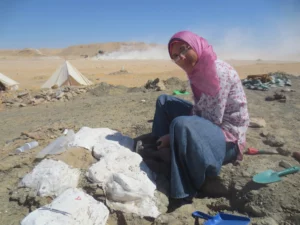 Zaterdag 7 mei (online), 21.00 uur
Zaterdag 7 mei (online), 21.00 uurRediscovering Egypt’s Lost Dinosaurs
Sanaa El-Sayed and Matt LamannaEgypt’s vast archaeological record and engaging material culture have long excited people around the world, but did you know that this region’s history stretches back well into the Mesozoic Era, or Age of Dinosaurs? In the early 20th century, a series of German expeditions recovered fossils of several new and extraordinary ~95-million-year-old dinosaur species from the Bahariya Oasis in Egypt’s Western Desert, most famously the enormous sail-backed semi-aquatic predator Spinosaurus aegyptiacus. Tragically, however, all these fossils were destroyed during a British Royal Air Force bombing of Munich in late April 1944. In 2000, a collaborative Egyptian-American research team co-led by Matt Lamanna became the first scientists to discover dinosaur fossils in the Bahariya Oasis in nearly a century; among these were a partial skeleton of a new and gigantic sauropod (long-necked plant-eating dinosaur) that was later named Paralititan stromeri.
More recently, researchers from the Mansoura University Vertebrate Paleontology Center in Mansoura, Egypt—including its co-founder, Sanaa El-Sayed—have collected additional, important dinosaur fossils from Bahariya, and moreover have expanded their paleontological efforts to include geologically younger (~75-million-year-old) sites in the Kharga and Dakhla oases. Foremost among their finds from the latter is another new sauropod, Mansourasaurus shahinae, which constitutes one of the best-preserved late Mesozoic-aged land-living backboned animals known from the entire African continent. Collectively, these discoveries have cast unprecedented light on Egypt’s remarkable dinosaurs, helping to restore a scientific legacy that was lost during the Second World War.
 Maandag 9 mei, 18.15 uur (hybdride)
Maandag 9 mei, 18.15 uur (hybdride)Die schulischen Ostraka aus dem Ramesseum
Dr. Christophe Barbotin (Louvre Museum, Paris)Zwischen 2002 und 2008 wurde eine große Zahl hieratischer Ostraka von Christian Leblanc, dem Direktor der « Mission archéologique française de Thèbes Ouest » in der südöstlichen Ecke des Ramesseum-Temenos entdeckt. Mit einigen Bild-Ostraka und Bildhauerstudien ergänzen sie das Material, das Quibell in den Jahren 1895 und 1896 an genau derselben Stelle des Tempels gefunden hatte und das von Spiegelberg 1898 veröffentlicht wurde. Zum großen Teil stammen diese Dokumente aus dem Schulkontext. Sie bilden eine außerordentliche Illustration der antiken Methoden des Schreiberunterrichts mit Beispielen zu allen Stufen, vom einzelnen und schlecht geformten hieratischen Zeichen bis zu literarischen Texten und selbst Hieroglyphen. Die neuen Ostraka werden im Vortrag präsentiert und diskutiert, mit einem Fokus auf die wichtigsten und sonderlichsten davon.
Donderdag 12 mei, 18.15 uur (online)
Ägyptisch-deutsche Ausgrabungen im Sonnentempel von Matariya/Heliopolis
Prof. Dr. Dietrich Raue (Universität Leipzig)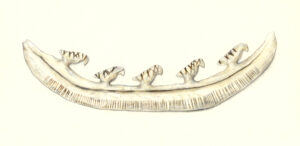 Donderdag 12 mei, 19.30 uur (online)
Donderdag 12 mei, 19.30 uur (online)De valk tijdens de predynastische en vroegdynastische periode
Dr. Stan Hendrickx (KU Leuven)Kosten: € 2,50 voor donateurs, € 5,- voor niet-donateurs, gratis voor studenten
De valk is zonder twijfel één van de belangrijkste symbolen van het koningschap in het Oude Egypte. De valk wordt gedurende de Naqada III periode bijzonder populair voor beeldjes, hangers en andere objecten. De populariteit van de vogel houdt aan in de Dynastische periode, waarbij vooral de combinatie met de serekh en koningsnamen opvalt. Deze elementen lijken in oorsprong onafhankelijk, maar worden met elkaar in verband gebracht vlak voor het begin van de 1e dynastie. In deze lezing zal Stan Hendrickx een overzicht geven van de documentatie die van de valk voorhanden is, gezien binnen de context van het ontstaan van de Egyptische staat.
 Woensdag 18 mei, 15.00 uur (hybride)
Woensdag 18 mei, 15.00 uur (hybride)NINO-EOL-voorjaarslezing:
Voor Babel en nadien. Schriften en Talen in het Oude Nabije Oosten
Marc Van de MieroopDe talrijke teksten van het Oude Nabije Oosten geven ons een breed palet aan schriften en talen, die de geschiedenis van de regio tot een van de meest interessante van de Oudheid maken. Deze lezing is gebaseerd op het boek Before and After Babel. Writing as Resistance in Ancient Near Eastern Empires, dat binnenkort zal verschijnen bij Oxford University Press. Ze schetst hoe het gebruik van talen en schriften radicaal veranderde tussen het tweede en het eerste millennium v.Chr. – voor Babel en nadien – en legt uit hoe we de explosie van nieuwe schriften kunnen interpreteren en dit in relatie tot de groeiende dreiging van de beruchte imperiums van Mesopotamië.
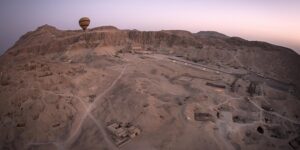 Donderdag 19 mei, 18.00 uur (online)
Donderdag 19 mei, 18.00 uur (online)The Middle Kingdom Theban Project: six seasons of archaeological and epigraphic work in the cemeteries of Deir el-Bahari and Asasif (Luxor)
Antonio Morales (Alcalá University)In the last six years, the University of Alcalá Expedition and its Middle Kingdom Theban Project have set up a multidisciplinary and international team of experts that is conducting archaeological excavation, epigraphic work, and conservation in several tombs in the area of Deir el-Bahari, with the major goal of improving our knowledge on the historical circumstances of the later part of the Eleventh Dynasty and the beginning of the so-called “Classical Period”. In this talk, Antonio Morales shall present the major aims and strategies developed to respond to the main questions of the project. Documenting, studying, and publishing several of these First Intermediate Period and Middle Kingdom monuments from Deir el-Bahari and Asasif will no doubt allow scholars to have a better understanding of the role of Thebes in the construction of the classical age in pharaonic history.
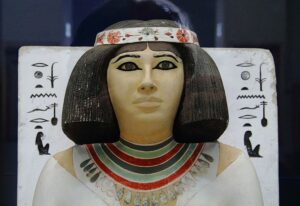 Zaterdag 28 mei, 19.00 uur
Zaterdag 28 mei, 19.00 uurWomen’s Work: Public and Private Power in Ancient Egypt
Dr. Jean LiThere is a well-known and often repeated characterization that Ancient Egyptian women were “better off” than their counterparts in other ancient civilizations. Join Dr. Jean Li for a discussion of this notion: To what extent was this true? Was it equally true both in the public (governmental) sphere and in the private sphere? What were the activities in which women engaged, and how did women exercise public and private power in society?
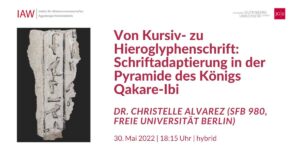 Maandag 30 mei, 18.15 uur (hybride)
Maandag 30 mei, 18.15 uur (hybride)Von der Kursiv- zur Hieroglyphenschrift: Schriftadaptierung in der Pyramide des Königs Qakare-Ibi
Dr. Christelle Alvarez (Freie Universität Berlin)Ritualtexte, die in den unterirdischen Bereichen von Pyramiden gefunden wurden, wurden von kursiven Inschriften auf Vorlagen in Hieroglyphen an den Wänden der Pyramiden übertragen. In den Texten der Pyramide von Ibi (8. Dynastie) sind Spuren dieser Textanpassung, aber auch der Schriftanpassung, sichtbar. Diese Präsentation gibt einen Überblick über den Prozess der Textanpassung und fokussiert auf die Materialität des Schreibens. Ziel ist es, die Beziehung zwischen Inschriften auf Vorlagen und Wänden zu beleuchten und die kognitiven Prozesse der Schriftadaptierung hervorzuheben.
 Maandag 30 mei, 18.15 uur (online)
Maandag 30 mei, 18.15 uur (online)Cities, regions, and trade: Power and state-building in ancient Egypt in the Bronze Age
Juan Carlos Moreno GarcíaSituated at the crossroads between North-eastern Africa, the Mediterranean, the Near East and the Indian Ocean, ancient Egypt was a strategic pathway that facilitated contacts and the circulation of peoples, products and ideas across these vast regions. Sometimes it was the monarchy that took the initiative in these contacts, whereas in other cases mobile populations, local leaders, itinerant merchants and independent individuals fulfilled such role.
Archaeology is gradually revealing the importance of these actors, usually neglected in official inscriptions that highlight, by contrast, the centrality of the monarchy and its institutions. At the same time, new methods of research cast a new light on the modalities of these contacts and the extent of the networks operative in the Bronze Age across these regions and, more generally, Eurasia. Finally, Egyptian regions participated in these exchanges in very distinctive ways, so control over flows of wealth, access to coveted goods and contacts with privileged trading partners represented significant moves in their strategies. A constant tension between different political models (centralized, confederacies of cities and territories, regional kingdoms) reemerged once and again through the millennia, led often to the collapse of the central authority and seem inspired, at least in part, by the impact of trading activities and exchanges.
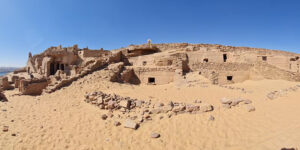 Maandag 30 mei, 20.30 uur
Maandag 30 mei, 20.30 uurThe 12th Dynasty Elite of Elephantine
Alejandro Jimenez-SerranoKosten: £5
The discovery of 12th Dynasty tombs in Qubbet el-Hawa at the end of the 19th century permitted scholars to understand the Middle Kingdom in the southernmost province of Upper Egypt. This data increased dramatically, when Labib Habachi discovered their ka chapels erected in a household shrine dedicated to Heqaib, a late 6th Dynasty governor who became their mythic ancestor. New excavations carried out by the University of Jaen in Qubbet el-Hawa have shed light on how the local elite was internally organised. Additionally, the discovery of intact tombs has given us much more data about the funerary customs of the highest members of the local community during the late 12th Dynasty.
Dinsdag 31 mei, 18.00 uur
Late Bronze Age Art and Cultural Exchange during the Age of “Internationalism” – Tutankhamun’s Golden Appliqués
Dr. Julia Bertsch (Tübingen)
-
Online museumnieuws
Allard Pierson
De tentoonstelling over dit onderwerp is inmiddels afgelopen, maar in dit filmpje vertelt kersverse conservator Ben van den Bercken over het project waarbij de dierenmummies in het Allard Pierson radiologisch zijn onderzocht.
Vorig jaar verwierf het museum een shabti (grafbeeldje) van de Nubische koning Senkamanisken. In dit blog lees je meer over het beeldje. Tot 15 mei is er tevens een kleine tentoonstelling over te zien.
Rijksmuseum van Oudheden
Ondanks dat de musea weer open zijn heeft het RMO in Leiden de online gemeenschap omarmd. Regelmatig zijn er gratis online lezingen te volgen, zoals op 24 april over het dodenboek van Qenna door conservator Daniel Soliman.
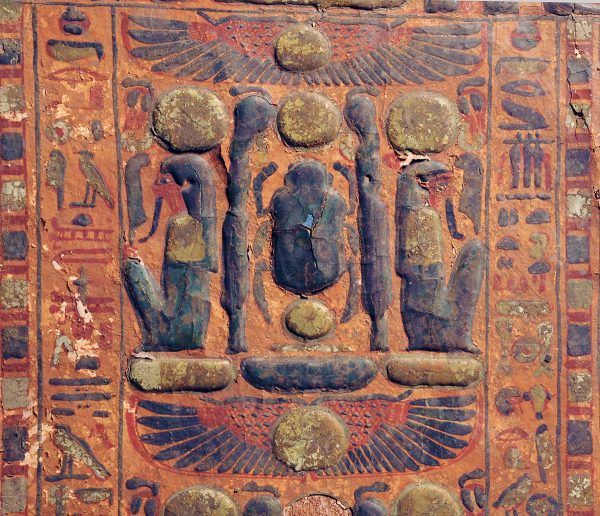
Detail van een mummiekist (F 93/10.1a.1) uit het RMO Ook zijn er op de website online tentoonstellingen te zien, zoals deze over mummiekisten gemaakt door Marein Meijer en Helbertijn Krudop.
Student Lauren van Kruijssen heeft een informatieve online tour gemaakt over de sarcofaag van Wahibreemachet, een Griekse migrant in Egypte uit de 26e dynastie.
Berlijn
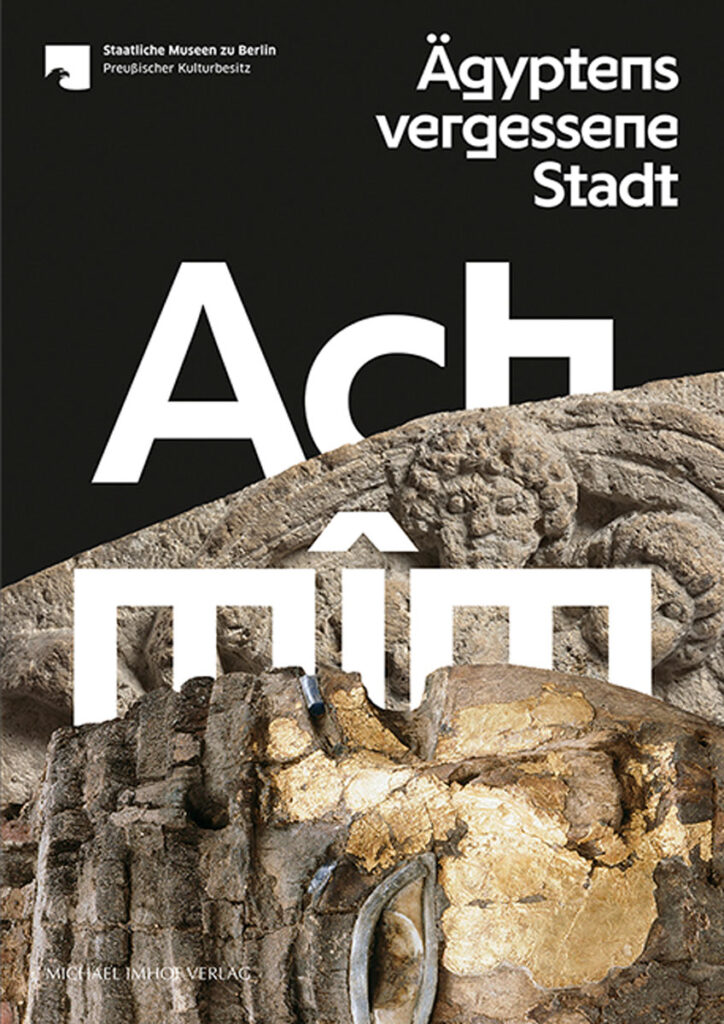
Online kunt u virtueel door de tentoonstelling Achmim: Ägyptens vergessene Stadt wandelen. Achmim is een van Egypte’s oudste steden waarvan de archeologische resten over de wereld verspreid zijn geraakt. In deze tentoonstelling wordt het verhaal verteld van deze religieus, politiek en cultureel belangrijke stad. De informatie is ook in het Engels beschikbaar.
Dodenboekpapyri
Op de website van Dik van Bommel kunt u een aantal papyri bekijken uit het Egyptisch Museum in Cairo, die op hoge resolutie gefotografeerd zijn.
Bekijk hier als voorbeeld het dodenboekpapyrus van Tashedkhonsu door op de afbeelding te klikken:
Ramose
Op de website Osirisnet staat nu het graf van Ramose (TT55) in Luxor uitvoerig besproken. Dit graf, dat toegankelijk is voor toeristen, is interessant door de combinatie van reliëf, schilderkunst en Amarna-afbeeldingen.
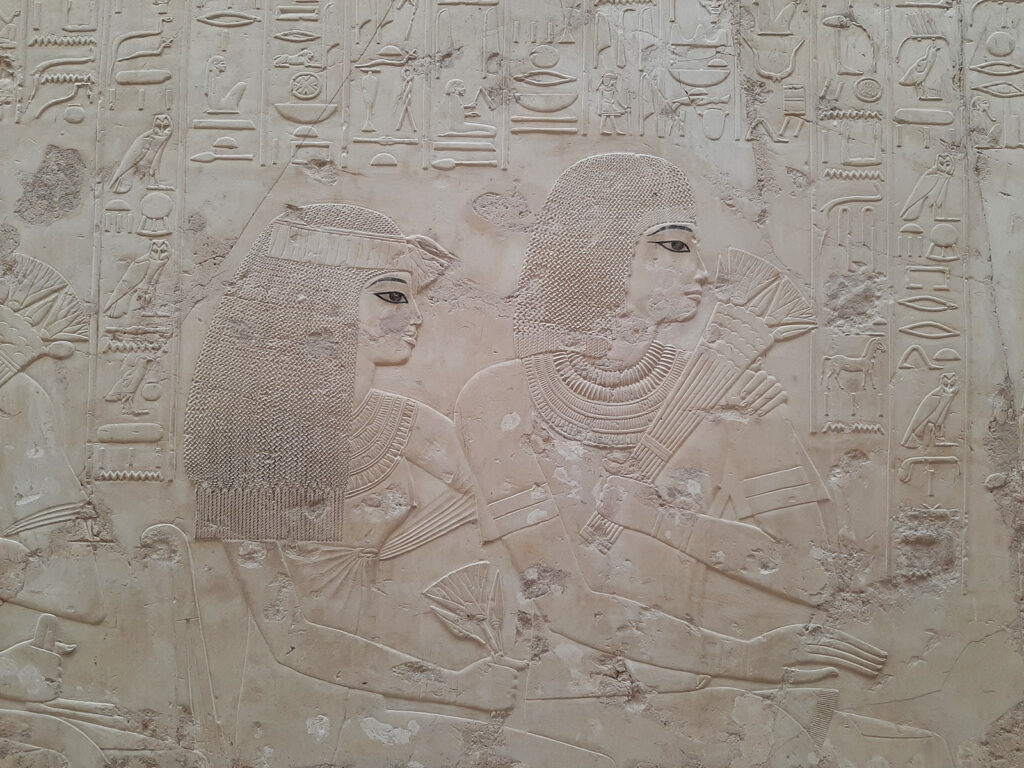
Scène in het graf van Ramose (foto: Nicky van de Beek) 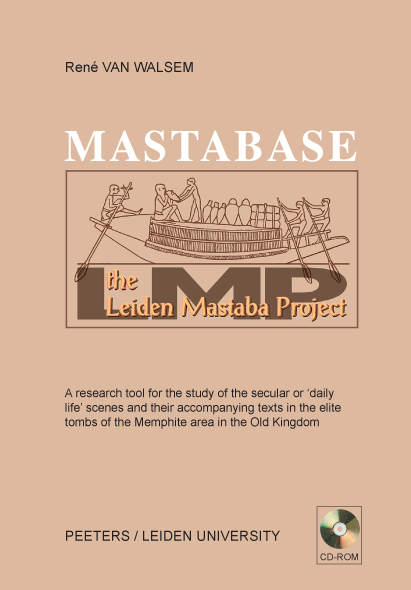 MastaBase
MastaBaseDe database met scènes uit Ouderijks elitegraven van René van Walsem is nu te downloaden van online repositorium Zenodo. Veel studenten Egyptologie uit Leiden hebben hun BA en MA-scripties geschreven met behulp van deze tool. Een handleiding met informatie over de meest gebruikte zoekfuncties is bijgevoegd. Aan een versie die geschikt is voor Mac-gebruikers wordt nog gewerkt.
-
Lezingen in december
Even leek het erop dat het leven zich weer offline kon afspelen, maar voor de binnenblijvers hebben we weer een aantal mooie lezingen en congressen op een rijtje gezet:
Dinsdag 7 december, 17.00 uur
Between plan and reality: The Lepsius cemetery in Dahshur
Anna Grünberg (Universität Leipzig)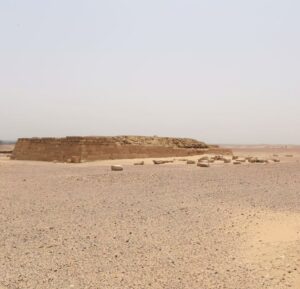
The necropolis of Dahshur forms an important part of the royal burial landscape of the Old and Middle Kingdom. Therefore, it offers plenty of opportunities to draw and specify various lines of development not only of royal but also elite funerary and cultic traditions. One interesting area in regard of such questions is the one of the Lepsius mastaba cemetery, located centrally between the two pyramids of Snofru. With its over 20 tombs, all of which are arranged in straight rows and lines, it forms a direct link between the grid-like cemeteries at Meidum and Giza and therefore can help to better understand the idea and implementation of state-planned tombs. The basis of this and further topics of research is formed by the results of the excavations of the DAI Cairo in the area of the Lepsius Cemetery, parts of which are to be presented in the lecture.
Zaterdag 11 december, 13 – 16.15 uur
Huis van Horus donateursdag
Kosten: €5 voor niet-donateursMet twee lezingen:
Europese aciviteiten in Sheikh Abd el-Qurna aan het begin van de 19e eeuw
Eva Cornelisse, MA
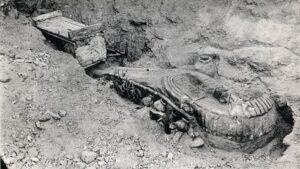
Het gebied rond het dorp Sheikh Abd el-Qurna, gelegen op de westelijke oever van de Nijl in Luxor, was zo’n 200 jaar geleden het toneel van activiteiten die wij ons nu niet meer zouden kunnen voorstellen. Na de veldtocht van Napoleon was in Europa de interesse in het oude Egypte sterk toegenomen, met name door de publicatie van de Description de l’Égypte. De machtsovername door pasha Mohammed Ali leidde tot een situatie van relatieve rust in het land, waardoor een groeiende stroom Europeanen de weg vond naar Egypte. Kunstenaars en reizigers, verzamelaars en handelaars, velen kwamen terecht in Qurna, waar nog veel te ontdekken viel. Het was een tijd van ongekende mogelijkheden, er waren nog geen regels of beperkingen en Egyptische oudheden werden in grote getale naar Europa verscheept. Wie waren deze mensen, dikwijls markante persoonlijkheden- met bijbehorende anekdotes- en hoe gingen zij te werk? Van graven als verblijfplaats tot mummiekisten als brandhout, deze lezing geeft een boeiend inkijkje in hoe het er aan toe ging in het Qurna in de tijd van de pioniers van de egyptologie.
Egypte door een Belgische lens: Jean Capart en de collectie historische foto’s van de KMKG
Wouter Claes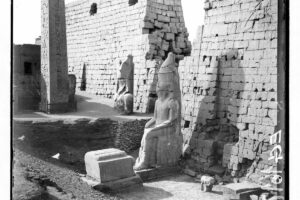
In de beroemde egyptologische bibliotheek van de Koninklijke Musea voor Kunst en Geschiedenis (KMKG) in Brussel wordt naast een grote collectie boeken en tijdschriften ook een bijzondere fotocollectie bewaard. Zij werd aangelegd onder het initiatief van Jean Capart (1877–1947), de grondlegger van de egyptologie in België, en bestaat uit meer dan 7000 fotografische glasnegatieven. In deze lezing nemen we een kijkje in deze unieke collectie en ontdekken we hoe deze foto’s een uitzonderlijke kijk bieden op de opkomst en het belang van de egyptologie in België en daarbuiten in de eerste helft van de 20ste eeuw.
Dinsdag 14 december, 18.15 uur
Neues aus Heliopolis. Ägyptisch-deutsche Ausgrabungen im August-Oktober 2021 im Sonnentempel von Matariya/Kairo
Florence Langermann and Prof. Dietrich Raue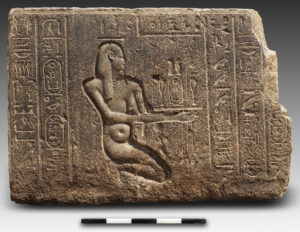
Die Ausgrabungen des Ägyptischen Ministeriums für Tourismus und Antiken, des Ägyptischen Museums der Universität Leipzig und des i3Mainz-Institut für Raumbezogene Informations- und Messtechnik der Hochschule Mainz berichten über jüngste Entdeckungen.
Woensdag 15 december, 18.30 uur
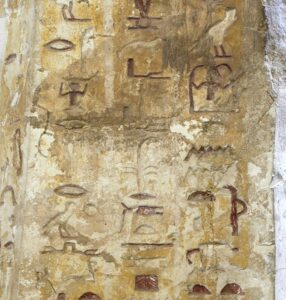 Von Monsterschlangen. Epigraphische Beobachtungen im Grab des Anchtifi von Hefat (Ende 3. Jt. v.Chr.)
Von Monsterschlangen. Epigraphische Beobachtungen im Grab des Anchtifi von Hefat (Ende 3. Jt. v.Chr.)
Prof. Dr. Ludwig Morenz en David Sabel MAAnchtifi von Hefat (heutige Region Mo’alla) ist eine der prägnantesten Figuren aus der ägyptischen Geschichte und ein besonderer „Zeitzeuge“ für das Ende des dritten Jahrtausends v. Chr. mit der Auflösung des Territorialstaates in der Zeit der Regionen. Seine Selbst-Präsentation wurde auf sieben Pfeiler seines Felsgrabes geschrieben. Zum Ausdruck ganz neuer Vorstellungen – einem geradezu „messianischen“ Anspruch als „Anfang der Menschen, Ende der Menschen“ – wurde eine neue Sprache geprägt, und diese Innovationskraft ging weiter bis in die Bild-Schriftlichkeit. Im Rahmen unserer Neuaufnahme des Grabes (in Kooperation mit der University of Liverpool) werden wir vier besondere Zeichen diskutieren, die uns neue Einblicke in die Vorstellungswelt eröffnen, darunter die Charakterisierung des erstmals bei Anchtifi genannten Anti-Gottes Apophis.
15 – 17 december
Making and Experiencing Graffiti in Ancient and Late Antique Egypt and Sudan
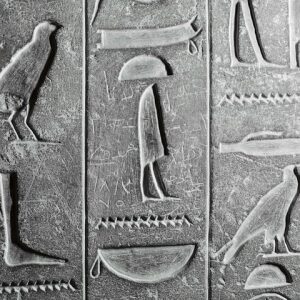
This the 2nd annual Nederlands Instituut voor het Nabije Oosten (NINO) postdoctoral fellowship conference, to be hosted online via Zoom, organised by Julia C. F. Hamilton as part of a two-year project on Old Kingdom graffiti at Saqqara.
Making and Experiencing Graffiti builds on recent graffiti-themed conferences in ancient and Late Antique Egypt and Sudan (e.g., Emberling and Davis 2019; Ragazzoli, Harmanşah, Salvador, Frood 2018), seeking papers to be presented under two major themes: ‘making’ and ‘experience’. In particular, papers that explore the mode, technique, and performance of graffiti-making are of interest, as are those which consider how textual and figural graffiti intersect with related corpora (e.g., mason’s and quarry marks, rock inscriptions, petroglyphs) along these lines, between the 3rd Millennium BCE – 7th century CE. A narrow definition of graffiti is eschewed, and speakers are encouraged to consider the socio-historical and practical circumstances in which marks and inscriptions were made and how they may respond to each other and other media around them.
Vrijdag 17 december, 18.30 uur
Im Bett mit den alten Ägyptern – Untersuchungen zum altägyptischen Schlafverhalten
Dr. Simone Gerhards (JGU Mainz)Auch im alten Ägypten wurde täglich geschlafen – diese Erfahrung war jedoch mit Assoziationen, Empfindungen und Metaphern verbunden, die sich von den heutigen unterscheiden. So wird der Schlaf nicht nur in alltäglichen Kontexten erwähnt und dargestellt, sondern spielt in der Literatur, Heilkunde, Religion, den Moral- sowie Jenseitsvorstellungen eine wichtige Rolle. Der Vortrag wird zwei große Themenbereiche zum Schlaf behandeln: Zum einen soll die Frage beantwortet werden, was über das tatsächliche Schlafverhalten bekannt ist (z. B. die Schlafdauer und die Gestaltung des Schlafplatzes). Zum anderen wird es darum gehen, was uns Texte und Bilder über das Wesen des Schlafes, seinen Einfluss auf den menschlichen Körper, die Umwelt und Gesellschaft verraten. Durch Vergleiche mit Schlafmustern anderer (antiker) Kulturen und unseren modernen Eigenheiten wird nach dem Vortrag sicher auch das eigene Schlafverhalten in einem neuen Licht erscheinen.
Zondag 19 december, 14.00 uur
RMO Topstukkenlezing: Het handschrift van Ipoewer
Lara Weiss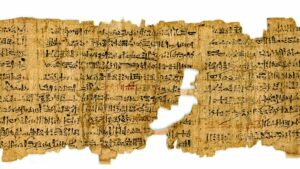
In deze topstukkenlezing vertelt conservator Lara Weiss over de ‘vermaningen’ van Ipoewer, het beroemdste Egyptische handschrift uit de collectie van het Rijksmuseum van Oudheden.
Ze gaat dieper in op de mogelijke archeologische herkomst, de inhoud en de verschillende duidingen van de tekst uit het Nieuwe Rijk (ca. 1307-1196 v.Chr.). Het handschrift van Ipoewer beschrijft de teloorgang van “de goeie ouwe tijd”, en de sociale ellende en burgeroorlog die daaruit voortvloeide.
Dinsdag 21 december, 20.00 uur
Chaos en Beheersing: Henri Asselberghs en zijn vriendschap met Jean Capart
Marleen De MeyerKosten: €4 voor niet-leden
 In 1961 publiceerde Henri Asselberghs een baanbrekende studie over de concepten van ‘chaos versus controle’ in de Predynastische en Vroegdynastische iconografie.
In 1961 publiceerde Henri Asselberghs een baanbrekende studie over de concepten van ‘chaos versus controle’ in de Predynastische en Vroegdynastische iconografie.Zijn boek lijkt echter uit het niets te komen, want niet alleen had Asselberghs nooit eerder over deze vroege periode van de Egyptische geschiedenis gepubliceerd, hij was niet eens Egyptoloog, maar directeur van het Spoorwegmuseum in Utrecht. Wie was deze Mijnheer Asselberghs, en hoe kwam hij tot zijn magnum opus? In deze lezing worden op basis van archiefbronnen en familiedocumenten zijn leven en carrière in de eerste helft van de 20e eeuw gereconstrueerd. Speciale aandacht gaat naar Belgisch Egyptoloog Jean Capart, met wie hij een kwart eeuw bevriend was, en die een cruciale rol speelde in zijn ontwikkeling als Egyptoloog.

